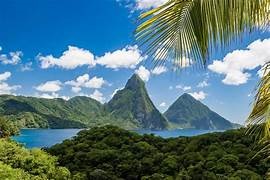Exploring the Natural Beauty of Saint Lucia
[tf_search_form style=’default’ type=’all’ fullwidth=’false’ classes=”” advanced=’enabled’]
Saint Lucia is a Caribbean island nation known for its stunning natural beauty. From its lush rainforests and towering mountains to its pristine beaches and crystal-clear waters, Saint Lucia is a paradise for nature lovers. The island is home to the world-famous Pitons, two volcanic spires that rise dramatically from the sea. These iconic landmarks are a UNESCO World Heritage Site and offer breathtaking views of the Caribbean Sea.
The island is also home to a variety of wildlife, including the endangered Saint Lucia parrot. This vibrant bird can be seen in the rainforest of the island’s interior, where it feeds on the nectar of the many flowering plants.
The waters around Saint Lucia are teeming with marine life, including dolphins, whales, and sea turtles. Snorkeling and diving are popular activities, and visitors can explore the coral reefs and shipwrecks that dot the coastline.
The beaches of Saint Lucia are some of the most beautiful in the Caribbean. From the white sands of Anse Chastanet to the black sands of Anse Cochon, there is something for everyone.
Saint Lucia is a paradise for nature lovers. From its lush rainforests and towering mountains to its pristine beaches and crystal-clear waters, the island offers a wealth of natural beauty to explore. Whether you’re looking for a relaxing beach vacation or an adventure-filled exploration of the island’s unique wildlife, Saint Lucia has something for everyone.
Exploring the Culture and Cuisine of Saint Lucia
Saint Lucia is a small Caribbean island nation located in the eastern Caribbean Sea. It is known for its stunning natural beauty, vibrant culture, and delicious cuisine. The culture of Saint Lucia is a unique blend of African, French, and British influences. The island is home to a variety of festivals and events that celebrate its culture and heritage.
The cuisine of Saint Lucia is a reflection of its diverse cultural influences. The island’s cuisine is a mix of African, French, and British flavors. Traditional dishes include callaloo, a soup made with okra, dasheen, and other vegetables; green figs and saltfish, a dish made with salted cod and green bananas; and bouyon, a stew made with beef, pork, or chicken. Seafood is also popular in Saint Lucia, with dishes such as grilled fish, conch, and lobster.
The island is also known for its unique desserts. Coconut tarts, sweet potato pudding, and banana bread are all popular desserts. Rum is also a popular drink in Saint Lucia, and the island is home to several rum distilleries.
Saint Lucia is a great destination for those looking to experience the culture and cuisine of the Caribbean. From its vibrant festivals to its delicious cuisine, Saint Lucia is sure to provide an unforgettable experience.
Exploring the Historical Sites of Saint Lucia
Saint Lucia is a Caribbean island nation with a rich history and culture. It is home to many historical sites that are worth exploring. From ancient fortresses to colonial plantations, these sites offer a glimpse into the past and provide insight into the island’s unique heritage.
One of the most important historical sites in Saint Lucia is the Pigeon Island National Park. This park is home to two fortresses, Fort Rodney and Fort Charlotte, which were built by the British in the 18th century. The fortresses were used to protect the island from French and Dutch invasions. Visitors can explore the ruins of the fortresses and learn about the island’s history.
The Morne Fortune Historic Site is another important historical site in Saint Lucia. This site was the site of a major battle between the French and British in 1778. Visitors can explore the ruins of the fortifications and learn about the battle.
The Balenbouche Estate is a former sugar plantation that dates back to the 18th century. The estate is now a museum and visitors can explore the grounds and learn about the history of the plantation.
The Anse La Raye Fish Market is a historic fish market that has been in operation since the 18th century. Visitors can explore the market and learn about the island’s fishing industry.
The Soufriere Estate is a former sugar plantation that dates back to the 18th century. The estate is now a museum and visitors can explore the grounds and learn about the history of the plantation.
The Maria Islands Nature Reserve is a protected area that is home to a variety of wildlife. Visitors can explore the reserve and learn about the island’s unique flora and fauna.
These are just a few of the many historical sites in Saint Lucia that are worth exploring. Each site offers a unique insight into the island’s past and provides visitors with an opportunity to learn about the island’s rich history and culture.



No Responses